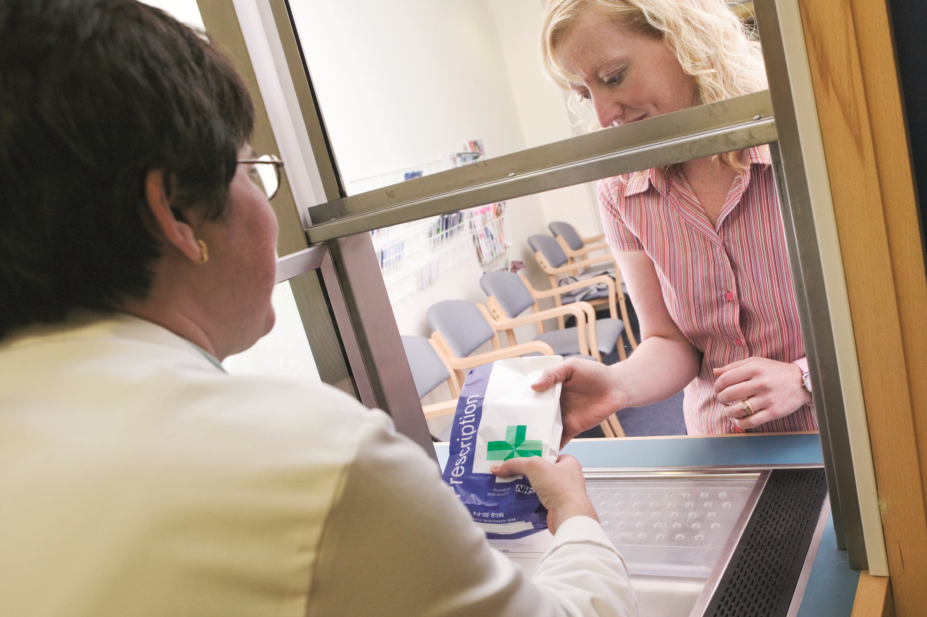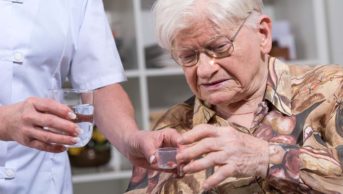
Gustoimages / Science Photo Library
An estimated 237 million medication errors occur in England every year. Although three-quarters of these errors are unlikely to result in harm, avoidable adverse drug reactions are directly responsible for the deaths of 712 patients every year, and a contributory factor in the deaths of thousands more[1]
.
Last month, secretary of state for health and social care, Jeremy Hunt, announced that the NHS would implement a series of measures to reduce the number of medication errors, focusing on employing new technology, improving transparency, and embedding a culture of learning, rather than blame.

Source: Wikipedia Commons
Health and social care secretary, Jeremy Hunt, announced that the NHS would implement a series of measures to reduce the number of medication errors
Details are outlined in a report from the Short Life Working Group (SLWG)[2]
, published to coincide with Hunt’s announcement, which advises on how improve medication safety in response to the World Health Organization’s (WHO) launch of its third Global Patient Safety Challenge: Medication Without Harm in 2017. WHO aims to reduce severe avoidable medication-related harm globally by 50% in five years[3]
.
Handwriting and errors
Given the legendary illegibility of doctors’ handwriting, there has always been a danger that handwritten scripts will be misread in the pharmacy, and that the wrong drug or dosage is dispensed as a result. As such, electronic prescribing has been the norm in primary care for many years.
But it is a different story in secondary care, leading Hunt to say that implementation of electronic prescribing and medicines administration systems across NHS hospitals will be accelerated.
Although electronic prescribing and medicines administration systems in hospitals have the potential to halve the incidence of high-risk medication errors[2]
, in November 2017, just 35% of acute trusts (where more than 80% of inpatients’ prescriptions are written digitally), and less than 12% of mental health organisations had rolled out the neccessary systems.
The reason, according to the report, is that electronic prescribing and medicines administration systems are “possibly one of the most challenging digital health systems to implement in provider organisations”, and typically take 18 to 24 months to implement because they require considerable change to working practices for medical, nursing and pharmacy staff.
At the time electronic prescribing was introduced in primary care, appropriate packages were not available for secondary care, says Alice Oborne, consultant pharmacist for medication safety at Guy’s and St Thomas’ NHS Foundation Trust.
“Electronic prescribing in UK primary care is not required to record drug administration, whereas if you’re going to have an electronic system with prescribing in hospitals, it makes absolute sense to have administration alongside [so time of administration and dose given can be recorded],” she says. “It did mean that it took longer for providers developing that software.”
Technology and errors
GPs issue prescriptions for a defined course of a drug while sitting at their desk.In secondary care, however, staff are often on their feet, moving through the wards and issuing more complex prescriptions for drugs and fluids that require dosage calculations, drugs that require intravenous or other non-oral administration, and drugs that require monitoring. Being able to record the administration contemporaneously is as important as the prescription itself. “The nurse needs to be able to take the drug to the patient, do all their safety checks, administer the drug and then record that administration,” Oborne explains. If the nurse has to do this at a desktop computer, there is a risk of distraction before this is done, leading to records not being up to date, which means portable devices running the appropriate software are needed.
Getting the necessary hardware in place, including reliable Wi-Fi networks throughout the hospital, is a major task in implementing electronic prescribing, Oborne says.
Hunt also announced plans for new systems linking prescribing data in primary care to hospital admissions. Hospital staff will be able to access GP prescribing information to ascertain whether a prescription may have contributed to a patient being admitted. This is already possible with the enhanced summary care record (SCR), where reviewing the clinical record and drugs on admission facilitates optimisation of medication. However, extraction from SCR has to be done manually, so it would be more efficient if this information could be automatically populated, Oborne says.
Feeding back into primary care
Around 71% of errors with the potential to cause harm are prescribed in primary care[1], so the plan is to feedback hospital admissions data to clinical commissioning groups.
NHS Digital and NHS Business Services Authority (BSA) are developing prescribing indicators to reduce preventable admissions to hospitals associated with high-risk prescribing. These will link patient-level and identifiable primary care prescribing data (available from NHSBSA) with hospital episode statistics data on admission/episodes of care (available from NHS Digital). The data will be published in a dashboard that will assess the person’s position and monitor their progress — similar to how GP antibiotic prescribing behaviour has been assessed to highlight outliers from normal behaviour. The first indicators to be rolled out will focus on gastrointestinal bleeds.
Some medicines-related admissions, such as those related to paracetamol overdose, are currently recorded and reported; however, most types are not, explains Steve Williams, a senior clinical pharmacist working for two general practices in Dorset, honorary clinical lecturer at the University of Manchester, and prior consultant pharmacist in medicine and medication safety at University Hospital of South Manchester NHS Foundation Trust.

Source: Courtesy of Steve Williams
Senior clinical pharmacist for two general practices, Steve Williams, says five classes of medicines are most likely to prompt potentially avoidable medicines-related hospital admissions: non-steroidal anti-inflammatory drugs, antiplatelets, anticoagulants, diuretics and antihypertensives
Determining whether an admission is medicines-related can be complex, as it may not be immediately recognised as such, and may require additional information and a degree of clinical judgement. But using metrics and a dashboard approach is the most important part of the plans that have been put forward, building on something that has been used at Wrexham Maelor Hospital in North Wales for many years, Williams says. Wrexham put a great emphasis on accurate and consistent medical coding to enable the patient journey and any associations to be studied. For example, if a patient in Wrexham who is on diuretics is admitted to hospital with an acute kidney injury, that information is coded. “They’re not saying that it is necessarily the cause, but they are linking them,” he says. It might be that the patient also had dehydration because of diarrhoea, and so, should be told to stop taking the diuretic for a couple of days if they start experiencing those symptoms again.
“This is a bit like the Scandinavian model of patient registries,” Williams explains. “In Scandinavia, everyone who is on a direct oral anticoagulant, for example, is in a registry. If they go to hospital, it gets recorded whether they went in with a stroke or bleeding into the stomach.”
When data are collated and compared, people may begin to worry they will be used to create something like a “school league table”, Williams adds. “But what we are interested in is unwarranted variation. If a particular area is well outside the normal distribution, one has to go and have a look.”
Rolling out interventions
The report also calls for the roll-out of proven interventions, such as the pharmacist-led information technology intervention (PINCER), to identify high-risk prescribing practice in general practice.
PINCER involves running searches on GP computer systems to identify patients at risk from hazardous prescribing. Pharmacists trained in PINCER can then work with each general practice to develop an action plan to address the issues identified.
PINCER has already been rolled out to 361 GP practices across 12 CCGs in the East Midlands, where it has identified 21,617 instances of hazardous prescribing in a patient population of just over 2.9 million people[2]
.
A detailed evaluation of its impact is being undertaken with funding from the National Institute for Health Research.
Technology will flag up an allergy if a clinician tries to prescribe penicillin to a patient who is allergic to it, Williams says. But the five classes of medicines most likely to prompt potentially avoidable medicines-related hospital admissions are non-steroidal anti-inflammatory drugs, antiplatelets, anticoagulants, diuretics and antihypertensives, he says. “If you look at those five groups, it is not about one decision today to prescribe it — a decision made ten years ago when a patient was 78 years old and, well, might not be the right one now they are 88 years old and frail.”
Sitting down with a patient to review their medicines, and stopping drugs or changing doses where necessary, is what Williams does every day. As he is based in general practice, he also has full access to the patient record and can write directly to it, which he says is necessary to do a thorough medication review.
A similar approach is being taken in care homes. NHS England is recruiting 240 pharmacists and pharmacy technicians to review the medicines taken by around 180,000 people living in care homes to help reduce overmedication and cut unnecessary hospital stays. On average, care home residents are prescribed seven medicines daily, and around 10% of people aged 75 years and over are currently prescribed ten or more medicines[4]
.
Results from the six NHS England care home vanguard sites piloting this approach showed that the reviews achieved a 27% cut in emergency hospital admissions, a 7% fall in the use of oral nutritional support, 30% fewer ambulance call-outs, and drug cost savings of £125–305 per resident.
Technology will also help improve the information available to patients and their carers by promoting “joint decision-making and healthy challenge between patients and healthcare professionals,” such as questioning the need for certain drugs.
Empowering patients
Guy’s and St Thomas’ has made a real effort to improve the information available to patients about medicines prescribed to them when in hospital, Oborne says. Patients are directed to two sources of written information about their medicine — the package insert and their discharge letter — and are asked to contact the hospital pharmacy or speak to a community pharmacist if they have questions. Patients are given the number for the medicines information department, and hospital pharmacy staff wear yellow badges encouraging patients to ask any questions they may have.
Regional medicines information departments have worked with NHS choices to create simple medicines information for patients, which is much simpler than package inserts, Oborne says. These are available at beta.nhs.uk.
Efforts to empower patients to take a greater interest in their medicines and become “their own safety advocate” can be further facilitated through the Medicines and Healthcare products Regulatory Agency (MHRA), working with industry to produce more patient-friendly packaging and labelling, the government-commissioned document says.
Efforts to empower patients to take a greater interest in their medicines and become “their own safety advocates” can be further facilitated through the Medicines and Healthcare products Regulatory Agency (MHRA), which is working with industry to produce more patient-friendly packaging and labelling, the government-commissioned document says.
Pharmacy dispensing system suppliers need to ensure that labelling contributes to safer use of medicines. Patients often rely on packaging to manage their medication, so reducing the frequency of changes might be helpful. Feedback on design is important, and the pharmaceutical industry may need to play a greater role in testing packaging and products with users, the report says.
It also calls for more work to be done to identify and increase awareness of ‘look-alike, sound-alike’ drugs, although new European rules coming in to tackle falsified medicines — which will add a unique identifier on medical products that must be scanned at fixed points along the supply chain — should help tackle this.
Leyla Hannbeck, chief pharmacist at the National Pharmacy Association (NPA), says: “Community pharmacies dispense in excess of 1 billion items every year and make 6.6 million enquiries about prescriptions that were received, so we do quite a lot in terms of checking the prescription.”

Source: National Pharmacy Association (NPA)
NPA chief pharmacist, Leyla Hannbeck, says pharmacists do “quite a lot in terms of checking” the more than 1 billion items dispensed annually
Every quarter, the NPA produces a medicines safety officer report, highlighting the most frequently reported errors, what pharmacists can do to avoid them, and the support and resources that are available. It also produces summary reports on specific risk areas. The NPA regularly raises concerns about packaging with the MHRA, which has led to changes in the past — for example, appropriate visual cues have been added to the packaging of chloramphenicol eye and ear products to reduce the risk of pharmacies dispensing the wrong product.
However, more work needs to be done on this by the MHRA, Hannbeck says: “There are loads of look-alike and sound-alike packagings, which is not very helpful in a busy pharmacy environment. Anything that can be done to reduce the likelihood of pharmacists making errors should be done.”
The MHRA has worked with the Commission on Human Medicines to produce a document outlining best practice in packaging design to aid the safe use of medicine.It said in a statement5: “We continue to work with manufacturers to see these principles being used routinely. We also work closely with NHS Improvement to analyse the root cause of medication errors and, where appropriate, ask for changes to medicines labelling where changes could be beneficial for both clinical staff and patients.”
Training on medication errors
Alongside these efforts, professional regulators must ensure adequate training in safe and effective medicines use is embedded in undergraduate training, and encourage reporting and learning from medication errors, the report says[6]
.
It recommends that multidisciplinary teams take more responsibility for supporting junior doctors in safer prescribing and highlights the pharmacist ‘buddy’ scheme as a good example of this, where foundation (F1) doctors shadowed the ward pharmacist for four days before starting work. Slips and knowledge-based mistakes are the most common type of prescribing error seen among F1 doctors when commencing a new job or rotation, and they have a prescribing error rate of 8.4%, almost all of which can be detected and corrected by a pharmacist, the report says[6]
.
An evaluation of a pharmacist buddy scheme in County Durham and Darlington NHS Foundation Trust found that F1 doctors reported increased confidence and felt less likely to make mistakes. Pharmacists said that the exercise improved their working relationship with junior doctors and 59% felt that the early opportunity to discuss prescribing and ward-based issues had reduced prescribing errors on the ward.
Duncan Rudkin, chief executive of the General Pharmaceutical Council, says the regulator will carefully consider the recommendations of the working group, including in relation to training in safe and effective medicines use within initial education and training and continuing professional development. He adds that the change in legislation in relation to dispensing errors was a “welcome step to support a learning culture, as it will remove a barrier for those working in registered pharmacies to improved reporting and learning”.

Source: General Pharmaceutical Council (GPhC)
GPhC chief executive, Duncan Rudkin, says it will consider recommendations on training in safe and effective medicine use within intitial education and CPD
Regulatory agencies and marketing authorisation holders are legally required to record and report side-effects to medicines, including medication errors. In 2017, the MHRA’s Yellow Card scheme received more than 44,000 reports of suspected adverse drug reports, and around 4% of reports relate to medication errors[7]
. The MHRA says that it has made efforts to increase the quantity and quality of reports, including in pharmacy integrating Yellow Card reporting into clinical IT systems, improving reporting forms to better capture adverse drug reaction information, and working with pharmacy bodies to promote reporting in a number of areas, including medication error. As a result, Yellow Card reporting from the pharmacy sector has increased by 322% over the last 10 years.
Finally, the SLWG report says, acute hospitals should move towards seven-day clinical pharmacy services. The NHS Specialist Pharmacy Service has been asked to build an online repository of good practice in safer use of medicines and early action areas; it has already begun gathering examples via NHS England and NHS Improvement regional pharmacists, and an initial searchable resource will be available later this year.
“A multi-pronged attack” is required to tackle medication errors, Williams emphasises. “You do want to encourage voluntary reporting, because that is the way to find new errors that you didn’t know about before, but it is also about collecting data using metrics — whether it is point prevalence studies, audits or medicines related admissions data — to point us in the direction of what we should be concentrating on, and crucially to see if we are improving.”
“But I don’t think anyone would disagree that we have enough data now to know where to put our efforts initially,” he concludes.
References
[1] Burns C. Pharmacy sector says transparency is key as Jeremy Hunt tackles drug errors. Available at: https://www.pharmaceutical-journal.com/news-and-analysis/news/pharmacy-sector-says-transparency-is-key-as-jeremy-hunt-tackles-drug-errors/20204459.article (accessed March 2018)
[2] Acute Care and Workforce, Acute Care and Quality & CQC Investigations and Quality Policy. The report of the Short Life Working Group on reducing medication-related harm. Available at: https://www.gov.uk/government/uploads/system/uploads/attachment_data/file/683430/short-life-working-group-report-on-medication-errors.p df (accessed March 2018)
[3] World Health Organization. WHO Global Patient Safety Challenge: Medication Without Harm. Available at: http://www.who.int/patientsafety/medication-safety/medication-without-harm-brochure/en/ (accessed March 2018)
[4] NHS England. Care home pharmacists to help cut overmedication and unnecessary hospital stays for frail older patients. https://www.england.nhs.uk/2018/03/care-home-pharmacists-to-help-cut-over-medication-and-unnecessary-hospital-stays-for-frail-older-patients/ (accessed March 2018)
[5] Medicines and Healthcare products Regulatory Agency. Best practice in the labelling and packaging of medicines. Available at: https://www.gov.uk/government/publications/best-practice-in-the-labelling-and-packaging-of-medicines (accessed March 2018)
[6] Guild of Healthcare Pharmacists and United Kingdom Clinical Pharmacy Association. 11th Joint National Conference Lifting the Lid: Facing the difficulties of maintaining and enhancing standards. Available at: http://ukclinicalpharmacy.org/wp-content/uploads/2017/05/UKCPA-GHP_Conference_Abstracts_May2015.pdf (accessed March 2018)
[7] European Medicines Agency. Guideline on good pharmacovigilance practices (GVP) Annex I - Definitions (Rev 2). Available at: http://www.ema.europa.eu/docs/en_GB/document_library/Scientific_guideline/2014/04/WC500165593.pdf (accessed March 2018)


